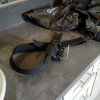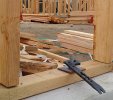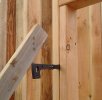- Joined
- Oct 13, 2002
- Messages
- 2,008
While the Winkler Knives II Emergency Response Tool is marketed as a breaching tool towards emergency responders, I wanted to verify its utility as a non-ERT multitool in a general construction environment. The premise is not for the ERT to supplant basic, specialized tools (e.g. screwdrivers), but to determine where and how the ERT can be useful in an environment where it is not explicitly designed for, yet where it is certainly not out of place at the same time. This will be a running review with insight gleaned across three residential construction sites in Southern California over a period of approximately one year (or shorter). The WKII ERT was purchased from BTactical Blades (BladeForums Dealer / Materials Provider). As a residential general contractor, the work I oversee begins from the purchase of property on through the entire improvement process. Suffice to say that as a second-generation GC, my labor is typically spent towards general pickup (intermittent hard use over short(er) durations) where the "jack-of-all-trades, master of none" idiom is well applied.
General Specifications:

Hammer Face | Wrench Cutouts (3/8" + 1/2" + 3/4") | 1/4" Universal Bit Holder...

Split-Tail Prybar Fork (Not Sized for 1/2" Slotted Gas/Water Meter Valves )....
)....

Birth Card | Verifying O-ring CS/ID (Bit Holder Not Sized for 1/2" Slotted Gas Meter Valves )....
)....

Initial Impressions:
Either the Caswell coating or the underlying steel is extremely porous as a drop of water onto the degreased tool surface would immediately be absorbed. I have treated the ERT four times which is three more times than I typically treat a blade. The first involved conventional paste after heating the tool with a heat gun before being left out in the sun for twenty minutes. Buffed surface did not appear any different than the original non-treated finish. The second application involved heating the tool with a heat gun before wrapping in aluminum foil and baking in a convection oven at 120F for fifteen minutes. Buffed surface appeared only slightly glossier than the original non-treated finish. The third round was the same as the second at which time the surface finally remained wet with FrogLube upon oven extraction. Buffed surface was only slightly glossier than the original non-treated finish but noticeably softer in feel. Drops of water would now bead on the tool surface. A fourth treatment was performed with results similar to the third. Treatment successful.

Demolition Notes:
Unless historic and other forms of preservation are required, demolition and clearing is typically performed by heavy machinery. Hand tools are only used when state regulators such as AQMD deem machine clearing too great a risk with respect to the introduction of hazardous materials into the air and the ground. As such, the removal and handling of hazardous waste becomes the responsibility of a licensed abatement contractor at which time the ERT can see use in removing positively marked items such as tile flooring. Where the ERT falls short is that the prybar end is not as wide as a purpose-specific scraper = Increased man-hours spent.
VERDICT: Can be used for precision hand demolition at the cost of speed.
Concrete Forming & Slab Pour Notes:
Perfect for adjusting and relocating duplex nails used for wood forms, string lines and nylon anchor bolt holders (e.g. AnchorMate). Can be used to lightly tap anchor bolts to free the threads from residual concrete. When a concrete vibrator is not required per spec or plan, it is still a good idea to strike the forms during a pour to consolidate the mix to reduce voids. The hammer feature of the ERT can be used, but is inefficient compared to a conventional framing hammer. Its lack of mass and short handle length limits head speed and the development of high kinetic energy and requires execessive bending to reach the bottom portion of wood forms. The ERT is able to drive rebar into wet concrete at the cost of speed.
VERDICT: Can be used during all stages of wood forming and slab work.
Rough Plumbing Notes:
Limited to light digging to adjust for sewer slope percentages.
VERDICT: Little to no use.
Rough Wood Framing Notes:
Ongoing phase (WIP)...


Perfect for Adjusting Trimmer Studs...

General Specifications:
- Length: 9.00"
- Thickness: 0.38"
- Material: 80CrV2
- Weight: 10.65 oz.

Hammer Face | Wrench Cutouts (3/8" + 1/2" + 3/4") | 1/4" Universal Bit Holder...

Split-Tail Prybar Fork (Not Sized for 1/2" Slotted Gas/Water Meter Valves

Birth Card | Verifying O-ring CS/ID (Bit Holder Not Sized for 1/2" Slotted Gas Meter Valves

Initial Impressions:
- 2 x AS568-112N70 O-rings offer purchase points and minimal shock absorption
- Received with an even Caswell finish though the coating can be removed with sufficient hand pressure
- Not an issue for a tool which will see hard use, but an observation nonetheless
- Unmilled hammer face can be used for finish work, though the Caswell coating may mark surfaces
- Neither the prybar fork nor the bit cutout can be used to engage slotted gas or water meter main valves
- An ERT multitool should support at minimum 1/2" residential gas and water meter valves
- Too small for standard hammer loop retention. Tool pouch storage recommended.
- Would have preferred greater distance between the hammer face and the handle
- Can we attach 5/8" OSB to DF #1 studs using 8d without mangling knuckles [TBD] ?
- Can we stitch 2 x DF #1 2x4 using 16d without mangling knuckles [TBD] ?
- Increasing head speed is the only way we can increase kinetic energy
- Short hammer head = narrow amplitude; Grip can contact striked surface
- Would have preferred a slight longer handle with increased width for a fuller grip
- Increasing handle width can be accomplished with a field wrapped handle
- Longer handle increases pendulum amplitude; Grip avoids contacting striked surface
- 1/4" bit holes can be used as paracord anchor points for a field wrapped handle
- Ships with one IVY Classic PH1 x SL#5-6 double-ended bit for finish work
Either the Caswell coating or the underlying steel is extremely porous as a drop of water onto the degreased tool surface would immediately be absorbed. I have treated the ERT four times which is three more times than I typically treat a blade. The first involved conventional paste after heating the tool with a heat gun before being left out in the sun for twenty minutes. Buffed surface did not appear any different than the original non-treated finish. The second application involved heating the tool with a heat gun before wrapping in aluminum foil and baking in a convection oven at 120F for fifteen minutes. Buffed surface appeared only slightly glossier than the original non-treated finish. The third round was the same as the second at which time the surface finally remained wet with FrogLube upon oven extraction. Buffed surface was only slightly glossier than the original non-treated finish but noticeably softer in feel. Drops of water would now bead on the tool surface. A fourth treatment was performed with results similar to the third. Treatment successful.

Demolition Notes:
Unless historic and other forms of preservation are required, demolition and clearing is typically performed by heavy machinery. Hand tools are only used when state regulators such as AQMD deem machine clearing too great a risk with respect to the introduction of hazardous materials into the air and the ground. As such, the removal and handling of hazardous waste becomes the responsibility of a licensed abatement contractor at which time the ERT can see use in removing positively marked items such as tile flooring. Where the ERT falls short is that the prybar end is not as wide as a purpose-specific scraper = Increased man-hours spent.
VERDICT: Can be used for precision hand demolition at the cost of speed.
Concrete Forming & Slab Pour Notes:
Perfect for adjusting and relocating duplex nails used for wood forms, string lines and nylon anchor bolt holders (e.g. AnchorMate). Can be used to lightly tap anchor bolts to free the threads from residual concrete. When a concrete vibrator is not required per spec or plan, it is still a good idea to strike the forms during a pour to consolidate the mix to reduce voids. The hammer feature of the ERT can be used, but is inefficient compared to a conventional framing hammer. Its lack of mass and short handle length limits head speed and the development of high kinetic energy and requires execessive bending to reach the bottom portion of wood forms. The ERT is able to drive rebar into wet concrete at the cost of speed.
VERDICT: Can be used during all stages of wood forming and slab work.
Rough Plumbing Notes:
Limited to light digging to adjust for sewer slope percentages.
VERDICT: Little to no use.
Rough Wood Framing Notes:
Ongoing phase (WIP)...
- Available fulcrums: Increasing leverage or is tool sufficient?
- Nail guns less depth gauges: Versus claw bar for overdriven nails?

Perfect for Adjusting Trimmer Studs...

Last edited:
